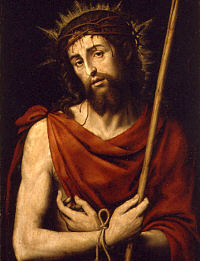| Meditations by Padre Pio |
||
|
The pivot of perfection is charity; he who lives in charity lives in God, because God is charity, as the Apostle says. |
||
| Meditations by Padre Pio |
||
|
The pivot of perfection is charity; he who lives in charity lives in God, because God is charity, as the Apostle says. |
||

Collect: Lord, protect us in our struggle against evil. As we begin the discipline of Lent, make this day holy by our self-denial. Grant this through our Lord Jesus Christ, your Son, who lives and reigns with you and the Holy Spirit, one God, for ever and ever. Amen.
 9th
9th The time has now come in the Church year for the solemn observance of the great central act of history, the redemption of the human race by our Lord and Savior Jesus Christ. In the Roman Rite, the beginning of the forty days of penance is marked with the austere symbol of ashes which is used in today's liturgy. The use of ashes is a survival from an ancient rite according to which converted sinners submitted themselves to canonical penance. The Alleluia and the Gloria are suppressed until Easter.
Abstinence from eating meat is to be observed on all Fridays during Lent. This applies to all persons 14 and older. The law of fasting on Ash Wednesday and Good Friday applies to all Catholics from age 18 through age 59.
Today is also the feast of St. Frances of Rome and Blessed John Ogilvie.
Ash Wednesday At the beginning of Lent, on Ash Wednesday, ashes are blessed during Mass, after the homily. The blessed ashes are then "imposed" on the faithful as a sign of conversion, penance, fasting and human mortality. The ashes are blessed at least during the first Mass of the day, but they may also be imposed during all the Masses of the day, after the homily, and even outside the time of Mass to meet the needs of the faithful. Priests or deacons normally impart this sacramental, but instituted acolytes, other extraordinary ministers or designated lay people may be delegated to impart ashes, if the bishop judges that this is necessary. The ashes are made from the palms used at the previous Passion Sunday ceremonies. — Ceremonies of the Liturgical Year, Msgr. Peter J. Elliott
At the beginning of Lent, on Ash Wednesday, ashes are blessed during Mass, after the homily. The blessed ashes are then "imposed" on the faithful as a sign of conversion, penance, fasting and human mortality. The ashes are blessed at least during the first Mass of the day, but they may also be imposed during all the Masses of the day, after the homily, and even outside the time of Mass to meet the needs of the faithful. Priests or deacons normally impart this sacramental, but instituted acolytes, other extraordinary ministers or designated lay people may be delegated to impart ashes, if the bishop judges that this is necessary. The ashes are made from the palms used at the previous Passion Sunday ceremonies. — Ceremonies of the Liturgical Year, Msgr. Peter J. Elliott
The act of putting on ashes symbolizes fragility and mortality, and the need to be redeemed by the mercy of God. Far from being a merely external act, the Church has retained the use of ashes to symbolize that attitude of internal penance to which all the baptized are called during Lent. — Directory on Popular Piety and the Liturgy
From the very early times the commemoration of the approach of Christ's passion and death was observed by a period of self-denial. St. Athanasius in the year 339 enjoined upon the people of Alexandria the 40 days' fast he saw practiced in Rome and elsewhere, "to the end that while all the world is fasting, we who are in Egypt should not become a laughing stock as the only people who do not fast but take our pleasure in those days." On Ash Wednesday in the early days, the Pope went barefoot to St. Sabina's in Rome "to begin with holy fasts the exercises of Christian warfare, that as we do battle with the spirits of evil, we may be protected by the help of self-denial."
— Daily Missal of the Mystical Body
Things to Do:
 Stational churches are the churches that are appointed for special morning and evening services during Lent, Easter and some other important days. The tradition started in order to strengthen the sense of community within the Church in Rome, as this system meant that the Holy Father would visit each part of the city and celebrate Mass with the congregation.
Stational churches are the churches that are appointed for special morning and evening services during Lent, Easter and some other important days. The tradition started in order to strengthen the sense of community within the Church in Rome, as this system meant that the Holy Father would visit each part of the city and celebrate Mass with the congregation.
The first stational church during Lent is St. Sabina at the Aventine. It was built in the 5th century, presumably at the site of the original Titulus Sabinae, a church in the home of Sabina who had been martyred c. 114. The tituli were the first parish churches in Rome. St Dominic lived in the adjacent monastery for a period soon before his death in 1221. Among other residents of the monastery were St Thomas Aquinas.
Visit "Station Churches", a Lenten Journey by Fr. Bill for more information about stational churches.